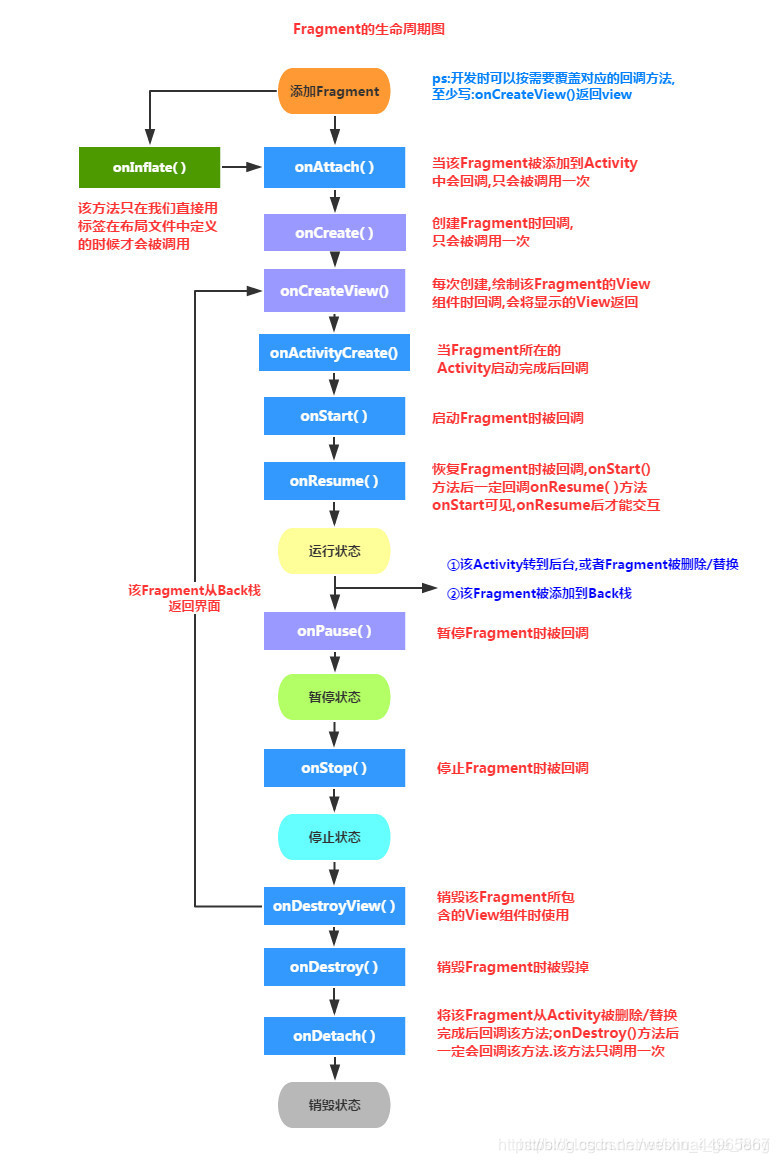fragment 简介
答:Fragment是Android3.0后引入的一个新的API,他出现的初衷是为了适应大
屏幕的平板电脑, 当然现在他仍然是平板APP UI设计的宠儿,而且我们普通手
机开发也会加入这个Fragment, 我们可以把他看成一个小型的Activity,又称
Activity片段!想想,如果一个很大的界面,我们 就一个布局,写起界面来会有
多麻烦,而且如果组件多的话是管理起来也很麻烦!而使用Fragment 我们可以
把屏幕划分成几块,然后进行分组,进行一个模块化的管理!从而可以更加方
便的在 运行过程中动态地更新Activity的用户界面!另外Fragment并不能单独使
用,他需要嵌套在Activity 中使用,尽管他拥有自己的生命周期,但是还是会受
到宿主Activity的生命周期的影响,比如Activity 被destory销毁了,他也会跟着
销毁!。
Fragment的优势
模块化(Modularity):我们不必把所有代码全部写在Activity中,而是把代码写在各自的Fragment中。
可重用(Reusability):多个Activity可以重用一个Fragment。
可适配(Adaptability):根据硬件的屏幕尺寸、屏幕方向,能够方便地实现不同的布局,这样用户体验更好。
创建Fragment
右键新建Fragment对象
内部执行的顺序是:
(1).定义一个类, 继承Fragment
(2).重写父类的方法onCreateView()
(3).在onCreateView()方法中, 为Fragment 创建UI界面
加载Fragment的两种方法
静态加载
自动生成XML文件
<?xml version="1.0" encoding="utf-8"?>
<FrameLayout xmlns:android="http://schemas.android.com/apk/res/android"
xmlns:tools="http://schemas.android.com/tools"
android:layout_width="match_parent"
android:layout_height="match_parent"
tools:context=".text.showfragment">
<!-- TODO: Update blank fragment layout -->
<TextView
android:id="@+id/context_tv_id"
android:layout_width="match_parent"
android:textColor="@color/colorAccent"
android:textSize="30sp"
android:layout_height="match_parent"
android:text="@string/hello_blank_fragment" />
</FrameLayout>
自动生成JAVA文件
public class showfragment extends Fragment {
private TextView textView;
public showfragment() {
// Required empty public constructor
}
@Override
public View onCreateView(LayoutInflater inflater, ViewGroup container, Bundle savedInstanceState) {
View inflate = inflater.inflate(R.layout.fragment_showfragment, container, false);
textView = inflate.findViewById(R.id.context_tv_id);
Bundle arguments = getArguments();
if(arguments!=null){
String key = arguments.getString("key");
textView.setText(key);
}
return inflate;
}
}
在需要加载fragment的activity中,想使用TextView一样,直接创建一个fragment即可.
已下是MainActivity中的xml文件
动态加载
linearLayoutId = findViewById(R.id.linear_layout_id);
fragmentManager= getSupportFragmentManager();
fragmentTransaction = fragmentManager.beginTransaction();
fragmentTransaction.add(R.id.linear_layout_id,new showfragment());
fragmentTransaction.commit();
一定要注意,如果用getSupportFragmentManager()这个方法,就整个项目全部用,
不要在项目里交叉使用getFragmentManager()方法.
add,remove,replace,hide 方法
FragmentManager supportFragmentManager = getSupportFragmentManager();
FragmentTransaction fragmentTransaction = supportFragmentManager.beginTransaction();
fragmentActivity fragmentActivity = new fragmentActivity();
com.example.class_four.fragment.fragmentActivity fragmentActivity1 = new fragmentActivity();
fragmentTransaction.add(R.id.fragment_id,fragmentActivity);
//移除一个Fragment
fragmentTransaction.remove(fragmentActivity);
//replace(替换一个布局)执行过程是先 remove 然后在 add.
fragmentTransaction.replace(R.id.fragment_id,fragmentActivity1);
fragmentTransaction.show(fragmentActivity1);
//隐藏一个Fragment
fragmentTransaction.hide(fragmentActivity1);
//提交事务
fragmentTransaction.commit();
Fragment的生命周期

文字描述 生命周期
1.onAttach() :Fragment与Activity有联系。
2.onCreate():创建Fragment
3.onCreateView():创建Fragment视图,尽量不要做耗时操作
4.onActivityCreated():当Activity中的onCreate方法执行完后调用。
5.onStart():启动。
6.onResume():可见
7.onPause():不可见
8.onStop():停止。
9. onDestroyView() :销毁Fragment视图
10.onDestroy():销毁fragment对象
11.onDetach():Fragment和Activity解除关联的时候调用








 本文详细介绍了Fragment在Android开发中的应用,包括其概念、优势、创建方法、生命周期及动态加载技巧。Fragment作为Activity的一部分,提供了更好的模块化、可重用性和适配性。
本文详细介绍了Fragment在Android开发中的应用,包括其概念、优势、创建方法、生命周期及动态加载技巧。Fragment作为Activity的一部分,提供了更好的模块化、可重用性和适配性。
















 530
530

 被折叠的 条评论
为什么被折叠?
被折叠的 条评论
为什么被折叠?








